扩展功能
文章信息
- 邱振, 卢斌, 陈振宏, 张蓉, 董大忠, 王红岩, 邱军利
- QIU Zhen, LU Bin, CHEN ZhenHong, ZHANG Rong, DONG DaZhong, WANG HongYan, QIU JunLi
- 火山灰沉积与页岩有机质富集关系探讨——以五峰组—龙马溪组含气页岩为例
- Discussion of the Relationship between Volcanic Ash Layers and Organic Enrichment of Black Shale: A case study of the Wufeng-Longmaxi gas shales in the Sichuan Basin
- 沉积学报, 2019, 37(6): 1296-1308
- ACTA SEDIMENTOLOGICA SINCA, 2019, 37(6): 1296-1308
- 10.14027/j.issn.1000-0550.2019.088
-
文章历史
- 收稿日期:2019-08-12
- 收修改稿日期: 2019-10-18
2. 国家能源页岩气研发(实验)中心,河北 廊坊 065007;
3. 中国石油新疆油田分公司勘探开发研究院,新疆 克拉玛依 834000;
4. 中国科学院西北生态环境资源研究院,兰州 730000;
5. 甘肃省油气资源研究重点实验室,兰州 730000
2. National Energy Shale Gas R & D(Experiment)Center, Langfang, Hebei 065007, China;
3. Research Institute of Petroleum Exploration and Development, PetroChina Xinjiang Oilfield Company, Karamay, Xinjiang 834000, China;
4. Northwest Institute of Eco-Environment and Resources, Chinese Academy of Sciences, Lanzhou 730000, China;
5. Key Laboratory of Petroleum Resources, Gansu Province, Lanzhou 730000, China
火山灰是火山喷发过程中产生的粒径小于2 mm的火山碎屑,一般伴随火山喷发气流长距离搬运并空降沉积[1-2]。在地质历史中,大规模火山活动与重大生物灭绝事件在时间上密切相关[3],常被认为是造成大规模海洋生物灭绝的诱发因素[3-5]。这是因为大规模(全球性)的火山喷发常伴随大量SO2气体和硫酸盐悬浮颗粒,从而形成酸雨、气候变冷等,导致生态环境极端恶化[6-7]。而在地质历史中火山灰也常与富有机质沉积如黑色页岩等相伴生[8-11],甚至在含凝灰质(火山灰)泥页岩中TOC可高达4%以上[12]。诸多研究表明,现代火山活动喷发形成的火山灰沉降到海水中可以提高海洋表层生产力[13-19],从而促进有机质形成与富集沉积。然而,目前地质历史时期火山灰(易蚀变为斑脱岩)沉积与有机质富集关系研究相对较少,且存在着争议[20-23]。一些研究认为火山灰沉积能够大幅度提高海洋生产力,有利于有机质富集沉积[10-12, 24-26],而部分学者认为它们之间关系并不密切[22-23, 27]。
全球奥陶纪—志留纪转折期发生一些重大事件,如近85%海洋动物物种迅速灭绝[28-32],海平面快速下降近100 m[33-34],气候短暂变冷(持续时间小于1 Ma)[35-37]等。近些年来,这些事件之间的成因关系或相互响应程度等科学问题一直是国际上重要的研究热点之一[31-33,35-39]。在这一重大转折期,北美、欧洲、北非、我国华南地区等广泛沉积了一套黑色富有机质页岩(国际上称为“hot shale”)[40-46](图 1),是全球古生代油气资源最重要的烃源岩层系之一。同时,这一时期北美、欧洲及我国华南等地区火山喷发活动也广泛发育,大量火山灰层被发现于页岩之中[8, 47-50](图 1)。华南地区的五峰组—龙马溪组页岩沉积相对连续,也是上奥陶统赫南特阶全球层型剖面所在地[3],该地区连续地记录这一时期有机质富集程度的变化,且火山灰层保存相对较好[8, 47, 49, 51-52],是开展火山灰沉积与有机质富集关系研究较为理想的地区。同时,五峰组—龙马溪组是我国页岩气的主要产层,目前已累计探明地质储量超1万亿立方米,2018年页岩气年产量已超100亿立方米。故本文以华南地区五峰组—龙马溪组含气页岩为例,初步探索地质历史中火山灰沉积对页岩有机质富集作用的影响,以期为我国页岩油气形成与富集提供基础理论支撑。
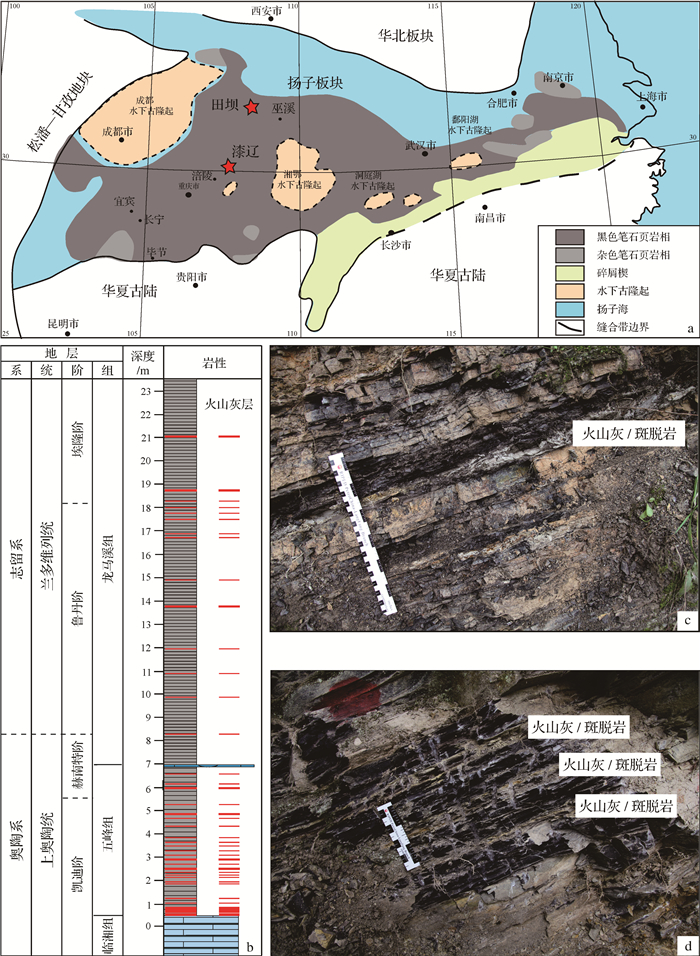
|
| 图 1 (a)华南地区五峰组—龙马溪组黑色页岩分布;(b)五峰组—龙马溪组内发育数层火山灰沉积(重庆巫溪田坝剖面),部分图例参考图 2、3;(c)龙马溪组页岩中火山灰沉积层;(d)五峰组页岩中火山灰沉积层 Fig.1 (a) Distribution of the Wufeng-Longmaxi black shales in South China; (b) volcanic ash layers of the Wufeng-Longmaxi Shale from the Tianba section in the Wuxi area, Chongqing (see legends in Fig. 2 and Fig. 3); (c) volcanic ash layers of the LongmaxiFormation; (d) volcanic ash layers of the Wufeng Formation |
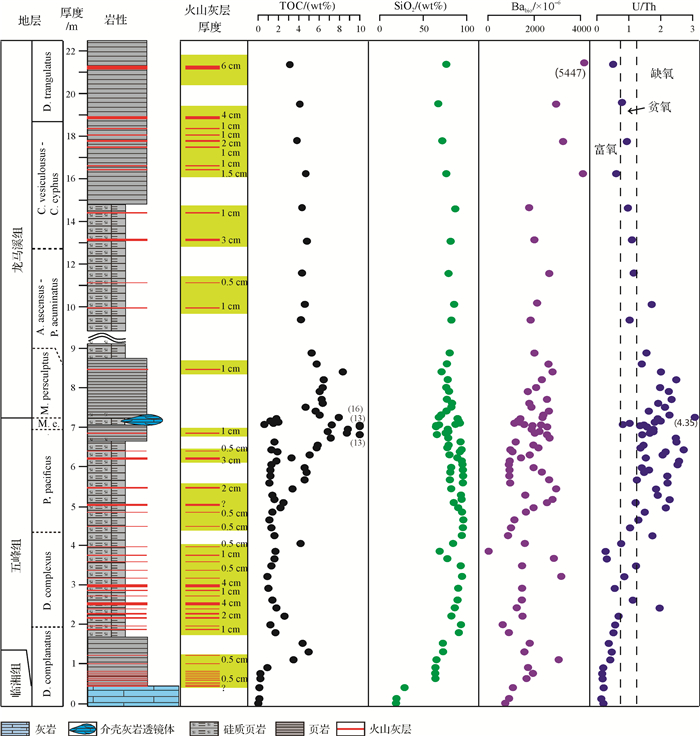
|
| 图 2 重庆巫溪地区田坝剖面五峰组—龙马溪组底部火山灰层分布、有机质富集相关指标(TOC含量、Babio含量、U/Th比值)特征(部分数据来自文献[39, 56-57],富氧—贫氧—缺氧仅表示沉积氧化还原条件变化趋势) Fig.2 Distribution of volcanic ash layers and total organic carbon (TOC) contents, Babio concentrations, and U/Th values of the lower part of the Wufeng-Longmaxi Shale in the Wuxi area, Chongqing (data from references [39, 56-57]) |
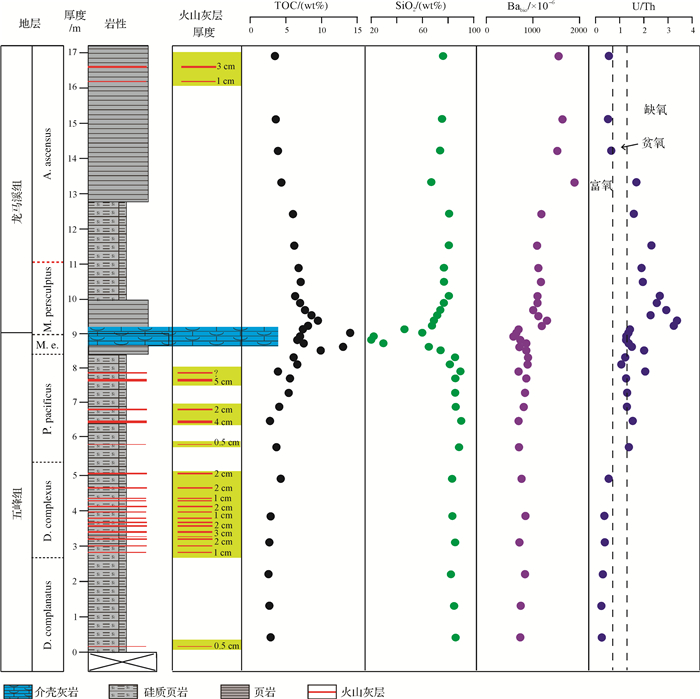
|
| 图 3 重庆石柱地区漆辽剖面五峰组—龙马溪组底部火山灰层分布、有机质富集相关指标(TOC含量、Babio含量、U/Th比值)特征(部分数据来自文献[39, 58-59],富氧—贫氧—缺氧仅表示沉积氧化还原条件变化趋势) Fig.3 Distribution of volcanic ash layers and TOC contents, Babio concentrations, and U/Th values of the lower part of the Wufeng-Longmaxi Shale in the Shizhu area, Chongqing (data from references [39, 58-59]) |
奥陶纪—志留纪转折期,我国华南地区位于古特提斯洋东部赤道附近,整体为陆表海环境,广泛发育上奥陶统五峰组—下志留统龙马溪组黑色富有机质页岩[41, 44, 53-55],并伴有大量火山灰层(易蚀变为斑脱岩)[8, 47, 50-53](图 1)。其中五峰组厚度一般5~20 m,主要由薄层黑色页岩、硅质岩等组成,富含笔石、放射虫等生物;龙马溪组厚度一般200~300 m,可分为两段,即龙一段和龙二段。上段主要由灰绿色页岩、粉砂质页岩、粉砂岩等组成,下段主要由黑色页岩、粉砂质页岩等组成,富含笔石生物。
笔者在四川盆地及周缘开展五峰组—龙马溪组野外考察过程中,观察到该套页岩层系中发育大量火山灰层。特别是在重庆石柱、巫溪等地区,五峰组火山灰层数可超过20层,龙马溪组底部也见到数层火山灰(图 1)。这些火山灰层厚度一般为1~ 4 cm,但整体变化较大,薄者以纹层出现,厚度不到5 mm,而厚者可达6 cm以上(图 1)。它们主要呈浅灰色、青灰色或土黄色,岩层分布相对稳定。总体上,与龙马溪组相比,五峰组中火山灰层发育相对密集。野外观察发现,距火山灰层约20 cm以内上覆、下伏岩层岩性变化相对较小。这意味着,它们如果在沉积时受到与火山活动相关作用(热源活动、火山灰沉积等)的影响,则受到的影响程度相近。本文选取重庆巫溪地区的田坝剖面和石柱地区的漆辽剖面作为研究对象,并依据两个剖面的火山灰层分布特征,总体上按照米级间距采集样品(图 2, 3)。为了更好对比研究火山灰层沉积对页岩有机质富集影响,对巫溪田坝剖面五峰组进行密集取样(一般 < 20 cm)以保证与火山灰层可能相关样品的数量(图 2)。共采集五峰组—龙马溪组页岩样品共计110件,其中巫溪地区田坝剖面为75件,石柱漆辽剖面为35件。2016—2019年期间,这些样品中大多数被陆续开展了TOC含量、主量元素、微量元素、铁组份、碳同位素等分析。基于这些数据,笔者及合作者们对它们沉积时期的海洋底部水体缺氧条件、表层古生产力、全球气候变化沉积响应、有机质富集条件、硅质岩成因等陆续进行了一些初步探讨[39, 56-59]。笔者以这些页岩样品已有的测试数据为研究基础,通过对火山灰沉积层附近(20 cm以内)即含火山灰的页岩层段(VRS)和相对远离火山灰沉积的正常沉积页岩层段(NS)的有机质差异富集特征分析,明确有机质富集的主控因素,以此探讨火山灰沉积与有机质富集关系。
2 五峰组—龙马溪组中火山灰沉积与页岩有机质富集关系探讨 2.1 含火山灰的页岩层段(VRS)与正常沉积的页岩层段(NS)有机质差异富集巫溪田坝剖面五峰组与龙马溪组的火山灰沉积较为发育,其中五峰组的略微密集。在五峰组内,厚度0.5 cm以上的火山灰层可达25层,龙马溪组底部的可见到13层(图 2)。而在石柱漆辽剖面,两者差异更为明显。五峰组内火山灰沉积层约19层,而在龙马溪组底部仅发育2层火山灰(图 3)。纵向上,两个剖面的页岩TOC含量均具有较大变化,其中田坝剖面TOC为0.6%~16%(平均值为4.1%),漆辽剖面的为2.6%~14%(平均值为6.0%)。同时,自底向上,两个剖面的TOC含量具有相似变化趋势即先逐渐增加后缓慢降低,其中峰值段位于五峰组顶部与龙马溪组底部(观音桥段附近)(图 2, 3)。
将火山灰沉积层附近20 cm以内页岩层段视为含火山灰页岩层(VRS)段,其余视为正常沉积的页岩层(NS)段。从图 2和图 3中可以得出,VRS段与NS段交互分布,是火山(群)间歇喷发的特征。统计表明,田坝剖面和漆辽剖面的VRS段TOC含量明显低于NS段的(图 4),具有明显的差异富集特征。其中田坝剖面VRS段TOC含量平均值约为3.1%,而NS段的该平均值为5.1%;在漆辽剖面,VRS段和NS段的TOC含量平均值分别约为3.6%和7.0%。
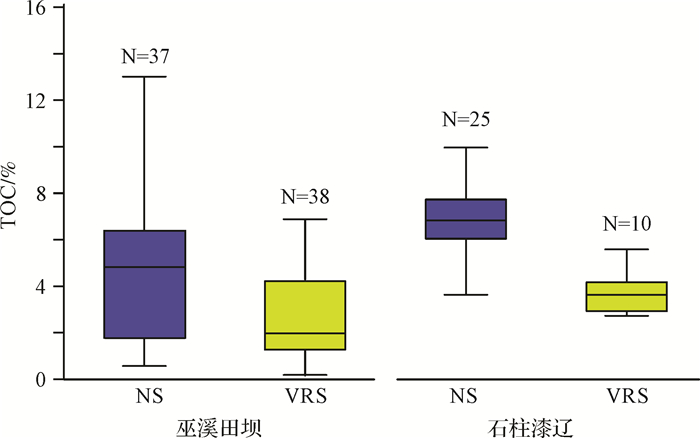
|
| 图 4 五峰组—龙马溪组中含火山灰页岩层段(VRS)与正常沉积页岩层段(NS)的TOC含量分布 Fig.4 TOC content distribution of shale horizon, includingvolcanic ash layers (VRS) and shale horizon normally deposited with no volcanic ash layer(NS) |
沉积物中有机质形成与富集的控制因素,尤其对于海相沉积物,一直存在着一些争论[60-67]。主要争论的焦点是保存条件(水体氧化还原条件)和海洋表层生产力,到底哪个是有机质富集的主控因素。早期研究普遍认为缺氧的保存条件是有机质富集的主要控制因素[60, 68-70]。然而,一些学者通过研究发现洋流上涌地区的富有机质沉积与海洋表层较高的(初级)生产力关系密切[71-74]。同时,有机质在沉积水体底部过程中,会发生分解作用消耗水体底部的氧气,从而可引发底部水体缺氧[61-75]。实际上,影响有机质富集的因素较多,如沉积速率[27, 65, 76-77]、黏土矿物含量[78-79]、海平面变化[72, 74, 80]等。综合而言,海洋中高生产力是有机质形成与富集的基础,缺氧保存条件、沉积速率等均是影响有机质富集非常重要的因素。
火山灰沉积对有机质形成与富集的影响,本质上体现在提高生物生产力方面。大量研究表明:现代火山喷发中火山灰能够释放大量Fe、P、N、Si、Mn等营养元素至海水中,从而能够促进海水表层中海洋生物生产力的提高[13-15, 17-18]。例如,在现代太平洋中,Fe元素含量相对较低,限制着其部分区域中浮游生物的生产力[81-83]。而在这些区域中Fe含量纳摩尔量级的增加,足以引发大规模硅藻的繁盛[7, 82, 84]。诸多研究已表明,现代火山喷发与近邻海洋中生物繁盛具有密切关系。例如,2003年马里亚纳群岛的阿娜塔翰(Anatahan)火山喷发引发了太平洋西北贫营养化区域中生产力的提高[16, 85];2008年美国阿拉斯加州卡萨托奇(Kasatochi)火山喷发促发了太平洋东北海域中浮游生物的繁盛[86-87];2010年冰岛的埃亚菲亚德拉(Eyjafjallajökull)火山灰喷发提高了北大西洋中冰岛盆地中生物生产力[19]。
近些年来,一些研究表明,生源钡(Babio)常作为现代和古代海洋生产力的指标[88-94]。生源钡计算方法参见文献[56]。如图 5所示,巫溪田坝剖面中含火山灰的页岩层段(VRS)Babio含量略高于正常沉积的页岩层段(NS),而石柱漆辽剖面中VRS段的Babio含量略低于NS段。故可以认为,在这两个剖面,火山灰沉积对其沉积时期的海洋生产力提高相对较弱,对有机质富集促进作用不明显。这一关系可能与五峰组—龙马溪组沉积时期海洋具有较高的生产力背景有关[44]。已有研究表明,现代火山灰携带的Fe、P、N、Si、Mn等营养元素,能够有效促进营养贫化海洋区域生物繁盛,提高初级生产力[7, 16, 84-85],但对于高生产力背景海洋区域影响可能较小。现代环太平洋赤道附近高生产力地区水体中Babio含量一般在1 000 ×10-6以上[95],而古代富有机质沉积物中Babio含量一般在500×10-6以上[96-97]。巫溪田坝和石柱漆辽地区的VRS段和NS段的Babio含量一般总体上高于500 ×10-6(图 5a,c),指示着该时期海洋表层总体上具有较高生产力。
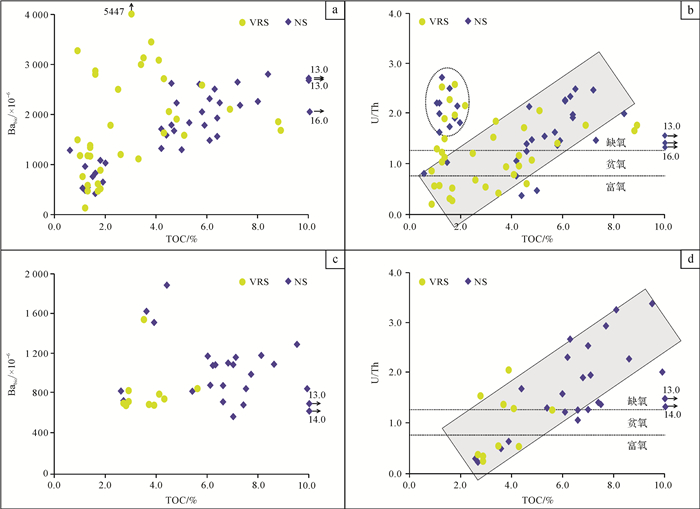
|
| 图 5 五峰组—龙马溪组火山灰页岩层段(VRS)与正常沉积页岩层段(NS)的TOC含量、生源钡Babio含量及U/Th比值交汇图(部分数据来自文献[39, 56-58],富氧—贫氧—缺氧仅表示沉积氧化还原条件变化趋势) (a)(b)巫溪田坝剖面(b中黑色虚线内样品富含放射虫);(c)(d)石柱漆辽剖面 Fig.5 Cross plots between TOC contents, Babio concentrations, and U/Th values of VRS and NS of the Wufeng⁃Longmaxi Shale(data from references [39, 56-58]) (a) and (b): Tianba section, Wuxi area; (c) and (d): Qiliao section, Shizhu area |
大量研究证实,微量元素中对水体氧化还原比较敏感的过渡元素(U、V、Mo、Ni、Cu等)在沉积物中的富集与否,可作为水体氧化还原条件的指标[62, 70, 98-99]。比较常用为微量元素比值,如U/Th, V/Cr等[99-100]。统计表明(图 5b,d),田坝剖面和漆辽剖面的U/Th比值与TOC含量均具有较好的正相关性,指示着氧化还原条件(富氧—贫氧—缺氧变化趋势)与有机质富集关系密切。需要说明的是,田坝剖面五峰组部分硅质岩样品(图 5b中黑色虚线所示)富含放射虫(图 6a)[57],这些硅质生物大量繁盛增加了沉积速率,对有机质及陆源碎屑具有一定稀释作用[65, 77],从而造成这些样品的TOC含量明显偏低,U/Th比值明显增高。另外,沉积速率对有机质富集的影响主要体现在岩性差异上。这两个剖面五峰组—龙马溪组岩性主要为灰黑色硅质页岩、薄层状硅质岩及块状泥灰岩(SiO2含量差异),除田坝剖面的上述富含放射虫样品(图 6b中黑色虚线所示)外,其余样品的TOC含量总体上受到岩性差异影响程度相对较弱(图 6b)。故可以进一步推测沉积速率对这些页岩有机质富集作用影响也相对较小。
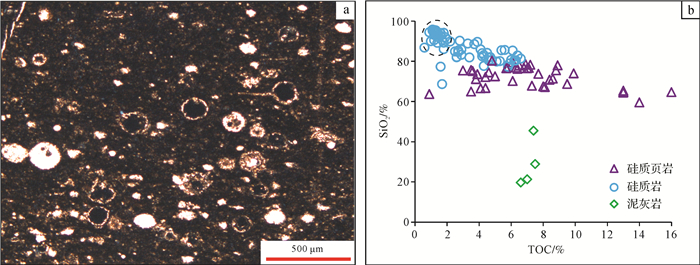
|
| 图 6 (a) 富含放射虫硅质岩,田坝剖面五峰组(来自文献[57]);(b)田坝剖面和漆辽剖面不同岩性TOC分布(部分数据来自文献[57, 59]) Fig.6 (a) Bedded chert with abundant radiolarians, Wufeng Formation from the Tianba section (figure from reference [57]); (b) TOC content distribution for different lithological samples from Tianba and Qiliao section (data from references [57, 59]) |
综上所述,尽管火山灰能够带来一定的营养元素并促进生产力的提高,但在奥陶纪—志留纪转折期海洋表层总体上具有较高生产力,致使火山灰的沉积对这一时期海洋生产力提高相对较弱。这可能是因为它所增加的有机质在后期沉降分解过程中,由于海洋氧化还原条件变化而被消耗掉。因此,可以认为火山灰沉积并未明显促进该时期的有机质富集,而氧化还原条件(富氧—贫氧—缺氧变化)与有机质含量关系密切,应该是这一时期有机质富集的主控因素。
3 存在问题与研究展望我国华南地区五峰组—龙马溪组页岩层系内所观察到火山灰沉积层,部分可能是构造活动引发层间滑动,致使硬度偏软的岩层发生碎裂、碾磨、黏土矿化等作用所形成的,类似断层泥。这是因为五峰组—龙马溪组相对厚度较大,岩石类型较多,包括硅质页岩、钙质页岩、薄层硅质岩、泥质粉砂岩、介壳灰岩等,且它们下伏为宝塔组(临湘组)厚层灰岩。这些岩性之间硬度差异较大,受构造活动影响,不同岩层之间易发生层间滑动,从而形成类似火山灰的薄夹层。因此,需要有效甄别这些非火山灰层。
已有研究表明,火山灰通常在大气中滞留时间只有1~3年[1],即使沉降到海水中,对海洋生产力的影响也仅为几年至数十年[17, 19]。这相对以百万年为单位的地质尺度,火山活动对海洋生产力影响常被认为是瞬间事件。由于火山喷发规模不同,相应的火山灰沉积厚度也会相差很大,厚者可达数米,薄者仅为几毫米,甚至直接完全溶解于水体,难以保存,以至难以厘定火山灰沉积所引发环境影响。尽管一些学者尝试从火山灰发育的富集段与非富集段对比角度分析其沉积的影响,但所取得认识仍存在着较大差异,这需要进一步对火山灰沉积层段开展更高分辨率(如厘米级、毫米级尺度)对比研究。另外,最新有研究表明,沉积物中黏土矿物种类对海洋有机质保存具有重要作用[101],即蒙脱石容易吸附海洋有机质,而陆源有机质与绿泥石等矿物在海水中能够紧密结合而不易发生变化。火山灰在海水中易分解成蒙脱石,从而有利于海洋有机质富集,但火山灰沉积对页岩中有机质富集贡献程度仍需进一步厘定。例如,页岩中火山灰发育集中层段即斑脱岩层有机质含量相对较低,而其发育较弱的页岩层段因火山灰分解或蚀变而难以厘定其贡献。
总之,火山活动对沉积环境的影响是十分复杂的过程,火山喷发产生的火山灰及相关的热液活动,不仅能够给水体带来丰富的营养元素,对水体化学性质及有机质保存也会产生些重要影响,这需要开展沉积地质学、岩石矿物学与元素、同位素等多指标地球化学等方面的综合研究,以此明确火山活动对有机质形成及富集作用的影响。同时,火山活动相关的沉积事件也是非常规油气沉积学的重要研究内容之一[102],厘定它与页岩有机质富集关系,对我国页岩油气勘探与开发具有重要意义。
4 结论地质历史时期火山灰沉积与有机质富集关系一直存在着争议。基于华南地区五峰组—龙马溪组的含火山灰页岩层段(VRS)与正常沉积的页岩层段(NS)的TOC含量、古生产力、氧化还原条件等特征的综合对比分析,初步得出以下认识。
(1)两剖面VRS段的TOC含量平均值分别约为3.1%和3.6%,明显低于NS段(分别为5.1%和7.0%),它们之间具有明显的差异富集特征。
(2)奥陶纪—志留纪转折期海洋表层总体上具有较高生产力,但火山灰沉积对其海洋生产力提高相对较弱,对有机质富集的促进作用不明显。
(3)氧化还原条件与TOC含量的关系表明,两个剖面的U/Th比值与TOC含量均具有较好的正相关性,指示着氧化还原条件(富氧—贫氧—缺氧变化趋势)与有机质富集关系密切,是这一时期有机质富集的主控因素。
由于火山活动对沉积环境影响是十分复杂的过程,未来需要利用地质、地球化学等多种测试手段,开展更高分辨率(如厘米级、毫米级尺度)综合对比研究,精细解剖火山活动对有机质形成及富集作用的影响。作为非常规油气沉积学重要研究内容之一,厘定其与页岩有机质富集关系,对我国页岩油气等非常规油气勘探与开发具有重要的指导意义。
致谢 在本文研究过程中得到了中国石油勘探开发研究院邹才能、朱如凯、王玉满和美国印第安纳大学Juergen Schieber等专家的指导和帮助,中科院西北生态环境资源研究院陶辉飞副研究员、同济大学蔡进功教授、东华理工大学韦恒叶副教授及两位审稿专家对本文提出了建设性意见,在此深表谢意。
| [1] |
Robock A. Volcanic eruptions and climate[J]. Reviews of Geophysics, 2000, 38(2): 191-219. doi: 10.1029/1998RG000054 |
| [2] |
陈宣谕, 徐义刚, Menzies M. 火山灰年代学:原理与应用[J]. 岩石学报, 2014, 30(12): 3491-3500. [Chen Xuanyu, Xu Yigang, Menzies M. Tephrochronology: Principles and applications[J]. Acta Petrologica Sinica, 2014, 30(12): 3491-3500.] |
| [3] |
Wignall P B. Large igneous provinces and mass extinctions[J]. Earth-Science Reviews, 2001, 53(1/2): 1-33. |
| [4] |
Wignall P B, Sun Y D, Bond D P G, et al. Volcanism, mass extinction, and carbon isotope fluctuations in the Middle Permian of China[J]. Science, 2009, 324(5931): 1179-1182. doi: 10.1126/science.1171956 |
| [5] |
Bond D P G, Hilton J, Wignall P B, et al. The Middle Permian (Capitanian) mass extinction on land and in the oceans[J]. Earth-Science Reviews, 2010, 102(1/2): 100-116. |
| [6] |
Self S, Widdowson M, Thordarson T, et al. Volatile fluxes during flood basalt eruptions and potential effects on the global environment: A Deccan perspective[J]. Earth and Planetary Science Letters, 2006, 248(1/2): 518-532. |
| [7] |
Cooper D J, Watson A J, Nightingale P D. Large decrease in ocean-surface CO2 fugacity in response to in situ iron fertilization[J]. Nature, 1996, 383(6600): 511-513. doi: 10.1038/383511a0 |
| [8] |
Su W B, Huff W D, Ettensohn F R, et al. K-bentonite, black-shale and flysch successions at the Ordovician-Silurian transition, South China: Possible sedimentary responses to the accretion of Cathaysia to the Yangtze Block and its implications for the evolution of Gondwana[J]. Gondwana Research, 2009, 15(1): 111-130. doi: 10.1016/j.gr.2008.06.004 |
| [9] |
Gaibor J, Hochuli J P A, Winkler W, et al. Hydrocarbon source potential of the Santiago Formation, Oriente Basin, SE of Ecuador[J]. Journal of South American Earth Science, 2008, 25(2): 145-156. doi: 10.1016/j.jsames.2007.07.002 |
| [10] |
张文正, 杨华, 彭平安, 等. 晚三叠世火山活动对鄂尔多斯盆地长7优质烃源岩发育的影响[J]. 地球化学, 2009, 38(6): 573-582. [Zhang Wenzheng, Yang Hua, Peng Ping'an, et al. The influence of Late Triassic volcanism on the development of Chang 7 high grade hydrocarbon source rock in Ordos Basin[J]. Geochimica, 2009, 38(6): 573-582. doi: 10.3321/j.issn:0379-1726.2009.06.007] |
| [11] |
Yang H, Zhang W Z, Wu K, et al. Uranium enrichment in lacustrine oil source rocks of the Chang 7 member of the Yanchang Formation, Erdos Basin, China[J]. Journal of Asian Earth Sciences, 2010, 39(4): 285-293. doi: 10.1016/j.jseaes.2010.03.013 |
| [12] |
王书荣, 宋到福, 何登发. 三塘湖盆地火山灰对沉积有机质的富集效应及凝灰质烃源岩发育模式[J]. 石油学报, 2013, 34(6): 1077-1087. [Wang Shurong, Song Daofu, He Dengfa. The enrichment effect of organic materials by volcanic ash in sediments of the Santanghu Basin and the evolutionary pattern of tuffaceous source rocks[J]. Acta Petrolei Sinica, 2013, 34(6): 1077-1087.] |
| [13] |
Frogner P, Gíslason S R, Óskarsson N. Fertilizing potential of volcanic ash in ocean surface water[J]. Geology, 2001, 29(6): 487-490. doi: 10.1130/0091-7613(2001)029<0487:FPOVAI>2.0.CO;2 |
| [14] |
Duggen S, Croot P, Schacht U, et al. Subduction zone volcanic ash can fertilize the surface ocean and stimulate phytoplankton growth: Evidence from biogeochemical experiments and satellite data[J]. Geophysical Research Letters, 2007, 34(1): L01612. |
| [15] |
Jones M T, Gislason S R. Rapid releases of metal salts and nutrients following the deposition of volcanic ash into aqueous environments[J]. Geochimica et Cosmochimica Acta, 2008, 72(15): 3661-3680. doi: 10.1016/j.gca.2008.05.030 |
| [16] |
Lin I I, Hu C M, Li Y H, et al. Fertilization potential of volcanic dust in the low-nutrient low-chlorophyll Western North Pacific subtropical gyre: Satellite evidence and laboratory study[J]. Global Biogeochemical Cycles, 2011, 25(1). |
| [17] |
Olgun N, Duggen S, Croot P L, et al. Surface ocean iron fertilization: The role of airborne volcanic ash from subduction zone and hot spot volcanoes and related iron fluxes into the Pacific Ocean[J]. Global Biogeochemical Cycles, 2011, 25(4). |
| [18] |
Olgun N, Duggen S, Andronico D, et al. Possible impacts of volcanic ash emissions of Mount Etna on the primary productivity in the oligotrophic Mediterranean Sea: Results from nutrient-release experiments in seawater[J]. Marine Chemistry, 2013, 152: 32-42. doi: 10.1016/j.marchem.2013.04.004 |
| [19] |
Achterberg E P, Moore C M, Henson S A, et al. Natural iron fertilization by the Eyjafjallajökull volcanic eruption[J]. Geophysical Research Letters, 2013, 40(5): 921-926. doi: 10.1002/grl.50221 |
| [20] |
金强, 翟庆龙. 裂谷盆地的火山热液活动和油气生成[J]. 地质科学, 2003, 38(3): 342-349. [Jin Qiang, Zhai Qinglong. Volcanic and thermal-water activities and hydrocarbon generations in the rift basins, eastern China[J]. Chinese Journal of Geology, 2003, 38(3): 342-349. doi: 10.3321/j.issn:0563-5020.2003.03.008] |
| [21] |
高福红, 高红梅, 赵磊. 火山喷发活动对烃源岩的影响:以拉布达林盆地上库力组为例[J]. 岩石学报, 2009, 25(10): 2671-2678. [Gao Fuhong, Gao Hongmei, Zhao Lei. Effects of volcanic eruptions on characteristics of source rocks: Taking Shangkuli Formation of Labudalin Basin as an example[J]. Acta Petrologica Sinica, 2009, 25(10): 2671-2678.] |
| [22] |
Shen J, Algeo T J, Hu Q, et al. Negative C-isotope excursions at the Permian-Triassic boundary linked to volcanism[J]. Geology, 2012, 40(11): 963-966. doi: 10.1130/G33329.1 |
| [23] |
王玉满, 李新景, 王皓, 等. 四川盆地东部上奥陶统五峰组—下志留统龙马溪组斑脱岩发育特征及地质意义[J]. 石油勘探与开发, 2019, 46(4): 653-665. [Wang Yuman, Li Xinjing, Wang Hao, et al. Developmental characteristics and geological significance of the bentonite in the Upper Ordovician Wufeng-Lower Silurian Longmaxi Formation in eastern Sichuan Basin, SW China[J]. Petroleum Exploration and Development, 2019, 46(4): 653-665.] |
| [24] |
Yan D, Wang H, Fu Q L, et al. Organic matter accumulation of Late Ordovician sediments in North Guizhou province, China: Sulfur isotope and trace element evidences[J]. Marine and Petroleum Geology, 2015, 59: 348-358. doi: 10.1016/j.marpetgeo.2014.09.017 |
| [25] |
Ran B, Liu S G, Jansa L, et al. Origin of the Upper Ordovician-Lower Silurian cherts of the Yangtze block, South China, and their palaeogeographic significance[J]. Journal of Asian Earth Sciences, 2015, 108: 1-17. doi: 10.1016/j.jseaes.2015.04.007 |
| [26] |
吴蓝宇, 陆永潮, 蒋恕, 等. 上扬子区奥陶系五峰组—志留系龙马溪组沉积期火山活动对页岩有机质富集程度的影响[J]. 石油勘探与开发, 2018, 45(5): 806-816. [Wu Lanyu, Lu Yongchao, Jiang Shu, et al. Effects of volcanic activities in Ordovician Wufeng-Silurian Longmaxi period on organic-rich shale in the Upper Yangtze area, South China[J]. Petroleum Exploration and Development, 2018, 45(5): 806-816.] |
| [27] |
Algeo T J, Henderson C M, Tong J N, et al. Plankton and productivity during the Permian-Triassic boundary crisis: An analysis of organic carbon fluxes[J]. Global and Planetary Change, 2013, 105: 52-67. doi: 10.1016/j.gloplacha.2012.02.008 |
| [28] |
Sepkoski J J Jr. Patterns of phanerozoic extinction:A perspective from global data bases[M]//Walliser O H. Global Events and Event Stratigraphy in the Phanerozoic:Results of the International Interdisciplinary Cooperation in the IGCPProject 216 "Global Biological Events in Earth History". Berlin, Heidelberg:Springer, 1996:35-51.
|
| [29] |
Sheehan P M. The Late Ordovician mass extinction[J]. Annual Review of Earth and Planetary Sciences, 2003, 29: 331-364. |
| [30] |
陈旭, 戎嘉余, 樊隽轩, 等. 奥陶系上统赫南特阶全球层型剖面和点位的建立[J]. 地层学杂志, 2006, 30(4): 289-305. [Chen Xu, Rong Jiayu, Fan Junxuan, et al. A final report on the global stratotype section and point (GSSP) for the Hirnantian Stage (Upper Ordovician)[J]. Journal of Stratigraphy, 2006, 30(4): 289-305. doi: 10.3969/j.issn.0253-4959.2006.04.001] |
| [31] |
Finnegan S, Bergmann K, Eiler J M, et al. The magnitude and duration of Late Ordovician-Early Silurian glaciation[J]. Science, 2011, 331(6019): 903-906. doi: 10.1126/science.1200803 |
| [32] |
Harper D A T, Hammarlund E U, C M Ø Rasmussen. End Ordovician extinctions: A coincidence of causes[J]. Gondwana Research, 2014, 25(4): 1294-1307. doi: 10.1016/j.gr.2012.12.021 |
| [33] |
Brenchley P J, Marshall J D, Harper D A T, et al. A Late Ordovician (Hirnantian) karstic surface in a submarine channel, recording glacio-eustatic sea-level changes: Meifod, central Wales[J]. Geological Journal, 2006, 41(1): 1-22. doi: 10.1002/gj.1029 |
| [34] |
Haq B U, Schutter S R. A chronology of paleozoic sea-level changes[J]. Science, 2008, 322(5898): 64-68. doi: 10.1126/science.1161648 |
| [35] |
Trotter J A, Williams I S, Barnes C R, et al. Did cooling oceans trigger Ordovician biodiversification? Evidence from conodont thermometry[J]. Science, 2008, 321(5888): 550-554. doi: 10.1126/science.1155814 |
| [36] |
Yan D T, Chen D Z, Wang Q C, et al. Large-scale climatic fluctuations in the latest Ordovician on the Yangtze block, South China[J]. Geology, 2010, 38(7): 599-602. doi: 10.1130/G30961.1 |
| [37] |
Finnegan S, Heim N A, Peters S E, et al. Climate change and the selective signature of the Late Ordovician mass extinction[J]. Proceedings of the National Academy of Sciences of the United States of America, 2012, 109(18): 6829-6834. doi: 10.1073/pnas.1117039109 |
| [38] |
戎嘉余, 黄冰. 生物大灭绝研究三十年[J]. 中国科学(D辑):地球科学, 2014, 44(3): 377-404. [Rong Jiayu, Huang Bing. Study of mass extinction over the past thirty years: A synopsis[J]. Science China (Seri. D): Earth Sciences, 2014, 44(3): 377-404.] |
| [39] |
Zou C N, Qiu Z, Poulton S W, et al. Ocean euxinia and climate change "double whammy" drove the Late Ordovician mass extinction[J]. Geology, 2018, 46(6): 535-538. doi: 10.1130/G40121.1 |
| [40] |
Lüning S, Craig J, Loydell D K, et al. Lower Silurian `hot shales' in North Africa and Arabia: Regional distribution and depositional model[J]. Earth-Science Reviews, 2000, 49(1/2/3/4): 121-200. |
| [41] |
Chen X, Rong J Y, Li Y, et al. Facies patterns and geography of the Yangtze region, South China, through the Ordovician and Silurian transition[J]. Palaeogeography, Palaeoclimatology, Palaeoecology, 2004, 204(3/4): 353-372. |
| [42] |
Sharma S, Dix G R, Villeneuve M. Petrology and potential tectonic significance of a K-bentonite in a Taconian shale basin (eastern Ontario, Canada), northern Appalachians[J]. Geological Magazine, 2005, 142(2): 145-158. doi: 10.1017/S001675680400041X |
| [43] |
Loydell D K, Butcher A, Frýda J. The Middle Rhuddanian (Lower Silurian) 'hot' shale of North Africa and Arabia: An atypical hydrocarbon source rock[J]. Palaeogeography, Palaeoclimatology, Palaeoecology, 2013, 386: 233-256. doi: 10.1016/j.palaeo.2013.05.027 |
| [44] |
陈旭, 樊隽轩, 张元动, 等. 五峰组及龙马溪组黑色页岩在扬子覆盖区内的划分与圈定[J]. 地层学杂志, 2015, 39(4): 351-358. [Chen Xu, Fan Junxuan, Zhang Yuandong, et al. Subdivision and delineation of the Wufeng and Lungmachi black shales in the subsurface areas of the Yangtze Platform[J]. Journal of Stratigraphy, 2015, 39(4): 351-358.] |
| [45] |
Mustafa K A, Sephton M A, Watson J S, et al. Organic geochemical characteristics of black shales across the Ordovician-Silurian boundary in the Holy Cross Mountains, central Poland[J]. Marine and Petroleum Geology, 2015, 66: 1042-1055. doi: 10.1016/j.marpetgeo.2015.08.018 |
| [46] |
Saberi M H, Rabbani A R, Ghavidel-Syooki M. Hydrocarbon potential and palynological study of the Latest Ordovician - Earliest Silurian source rock (Sarchahan Formation) in the Zagros Mountains, southern Iran[J]. Marine and Petroleum Geology, 2016, 71: 12-25. doi: 10.1016/j.marpetgeo.2015.12.010 |
| [47] |
苏文博, 何龙清, 王永标, 等. 华南奥陶—志留系五峰组及龙马溪组底部斑脱岩与高分辨综合地层[J]. 中国科学(D辑):地球科学, 2002, 32(3): 207-219. [Su Wenbo, He Longqing, Wang Yongbiao, et al. K-bentonite beds and high-resolution integrated stratigraphy of the uppermost Ordovician Wufeng and the Lowest Silurian Longmaxi Formations in South China[J]. Science China (Seri. D): Earth Sciences, 2002, 32(3): 207-219.] |
| [48] |
Histon K, Klein P, Schönlaub H P, et al. Lower Palaeozoic K-bentonites from the Carnic Alps, Austria[J]. Austrian Journal of Earth Sciences, 2007, 100: 26-42. |
| [49] |
Huff W D. Ordovician K-bentonites: Issues in interpreting and correlating ancient tephras[J]. Quaternary International, 2008, 178(1): 276-287. doi: 10.1016/j.quaint.2007.04.007 |
| [50] |
胡艳华, 孙卫东, 丁兴, 等. 奥陶纪—志留纪边界附近火山活动记录:来华南周缘钾质斑脱岩的信息[J]. 岩石学报, 2009, 25(12): 3298-3308. [Hu Yanhua, Sun Wei-dong, Ding Xing, et al. Volcanic event at the Ordovician-Silurian boundary: The message from K- bentonite of Yangtze Block[J]. Acta Petrologica Sinica, 2009, 25(12): 3298-3308.] |
| [51] |
胡艳华, 周继彬, 宋彪, 等. 中国湖北宜昌王家湾剖面奥陶系顶部斑脱岩SHRIMP锆石U-Pb定年[J]. 中国科学(D辑):地球科学, 2008, 38(1): 72-77. [Hu Yanhua, Zhou Jibin, Song Biao, et al. SHRIMP zircon U-Pb dating from K-bentonite in the top of Ordovician of Wangjiawan Section, Yichang, Hubei, China[J]. Science China (Seri. D): Earth Sciences, 2008, 38(1): 72-77.] |
| [52] |
卢斌, 邱振, 周杰, 等. 四川盆地及周缘五峰组—龙马溪组钾质斑脱岩特征及其地质意义[J]. 地质科学, 2017, 52(1): 186-202. [Lu Bin, Qiu Zhen, Zhou Jie, et al. The characteristics and geological significance of the K-bentonite in Wufeng Formation and Longmaxi Formation in Sichuan Basin and its peripheral areas[J]. Chinese Journal of Geology, 2017, 52(1): 186-202.] |
| [53] |
苏文博, 李志明, 史晓颖, 等. 华南五峰组—龙马溪组与华北下马岭组的钾质斑脱岩及黑色岩系:两个地史转折期板块构造运动的沉积响应[J]. 地学前缘, 2006, 13(6): 82-95. [Su Wenbo, Li Zhiming, Shi Xiaoying, et al. K-bentonites and black shales from the Wufeng-Longmaxi Formations (Early Paleozoic, South China) and Xiamaling Formation (Early Neoproterozoic, North China) - implications for tectonic processes during two important transitions[J]. Earth Science Frontiers, 2006, 13(6): 82-95. doi: 10.3321/j.issn:1005-2321.2006.06.011] |
| [54] |
樊隽轩, Melchin M J, 陈旭, 等. 华南奥陶-志留系龙马溪组黑色笔石页岩的生物地层学[J]. 中国科学(D辑):地球科学, 2012, 42(1): 130-139. [Fan Junxuan, Melchin M J, Chen Xu, et al. Biostratigraphy and geography of the Ordovician-Silurian Lungmachi black shales in South China[J]. Science China (Seri. D): Earth Sciences, 2012, 42(1): 130-139.] |
| [55] |
邹才能, 董大忠, 王玉满, 等. 中国页岩气特征、挑战及前景(一)[J]. 石油勘探与开发, 2015, 42(6): 689-701. [Zou Caineng, Dong Dazhong, Wang Yuman, et al. Shale gas in China: Characteristics, challenges and prospects (Ⅰ)[J]. Petroleum Exploration and Development, 2015, 42(6): 689-701. doi: 10.11698/PED.2015.06.01] |
| [56] |
邱振, 江增光, 董大忠, 等. 巫溪地区五峰组—龙马溪组页岩有机质沉积模式[J]. 中国矿业大学学报, 2017, 46(5): 1134-1143. [Qiu Zhen, Jiang Zengguang, Dong Dazhong, et al. Organic matter enrichment model of the shale in Wufeng-Longmachi Formation of Wuxi area[J]. Journal of China University of Mining & Technology, 2017, 46(5): 1134-1143.] |
| [57] |
邱振, 谈昕, 卢斌, 等. 四川盆地巫溪地区五峰组—龙马溪组硅质岩地球化学特征[J]. 矿物岩石地球化学通报, 2018, 37(5): 880-887. [Qiu Zhen, Tan Xin, Lu Bin, et al. Geochemical characteristics of cherts from the Wufeng and Longmaxi Formations in the Wuxi area, Sichuan Basin[J]. Bulletin of Mineralogy, Petrology and Geochemistry, 2018, 37(5): 880-887.] |
| [58] |
邱振, 卢斌, 江增光, 等. 五峰组—龙马溪组有机质富集因素及沉积模式:以四川盆地石柱地区为例[J]. 天然气工业, 2017, 37(增刊1): 32-41. [Qiu Zhen, Lu Bin, Jiang Zengguang, et al. Control factors and sedimentary pattern of organic matter enrichment in Wufeng-Longmaxi Formation - Taking Shizhu area of Sichuan Basin as an example[J]. Natural Gas Industry, 2017, 37(Suppl 1): 32-41.] |
| [59] |
Lu B, Qiu Z, Zhang B H, et al. Geochemical characteristics and geological significance of the bedded chert during the Ordovician and Silurian transition in the Shizhu area, Chongqing, South China[J]. Canadian Journal of Earth Sciences, 2019, 56(4): 419-430. doi: 10.1139/cjes-2018-0160 |
| [60] |
Demaison G J, Moore G T. Anoxic environments and oil source bed genesis[J]. Organic Geochemistry, 1980, 2(1): 9-31. doi: 10.1016/0146-6380(80)90017-0 |
| [61] |
Pedersen T F, Calvert S E. Anoxia vs. productivity: What controls the formation of organic-carbon-rich sediments and sedimentary rocks?[J]. AAPG Bulletin, 1990, 74(4): 454-466. |
| [62] |
Calvert S E, Pedersen T F. Geochemistry of Recent oxic and anoxic marine sediments: Implications for the geological record[J]. Marine Geology, 1993, 113(1/2): 67-88. |
| [63] |
Murphy A E, Sageman B B, Hollander D J, et al. Black shale deposition and faunal overturn in the Devonian Appalachian Basin: Clastic starvation, seasonal water-column mixing, and efficient biolimiting nutrient recycling[J]. Paleoceanography, 2000, 15(3): 280-291. doi: 10.1029/1999PA000445 |
| [64] |
Pichevin L, Bertrand P, Boussafir M, et al. Organic matter accumulation and preservation controls in a deep sea modern environment: An example from Namibian slope sediments[J]. Organic Geochemistry, 2004, 35(5): 543-559. doi: 10.1016/j.orggeochem.2004.01.018 |
| [65] |
Tyson R V. The "productivity versus preservation" controversy: Cause, flaws, and resolution[C]//Harris N B. The Deposition of Organic-Carbon-Rich Sediments: Models, Mechanisms, and Consequences. SEPM, Special Publication 82, 2005: 17-33. (ISBN 1-56576-110-3 https://www.onacademic.com/detail/journal_1000039776317110_d1a1.html
|
| [66] |
Mort H, Jacquat O, Adatte T, et al. The Cenomanian/Turonian anoxic event at the Bonarelli Level in Italy and Spain: Enhanced productivity and/or better preservation?[J]. Cretaceous Research, 2007, 28(4): 597-612. doi: 10.1016/j.cretres.2006.09.003 |
| [67] |
Katz B J. Controlling factors on source rock development-a review of productivity, preservation, and sedimentation rate[C]//Harris N B. The Deposition of Organic-Carbon-Rich Sediments: Models, Mechanisms, and Consequences. SEPM, Special Publication 82, 2005: 7-16. (ISBN 1-56576-110-3
|
| [68] |
Tyson R V, Pearson T H. Modern and ancient continental shelf anoxia: An overview[M]//Tyson R V, Pearson T H. Modern and Ancient Continental Shelf Anoxia. Geological Society, London, Special Publications, 1991, 58: 1-24.
|
| [69] |
Ingall E D, Bustin R M, van Cappellen P. Influence of water column anoxia on the burial and preservation of carbon and phosphorus in marine shales[J]. Geochimica et Cosmochimica Acta, 1993, 57(2): 303-316. doi: 10.1016/0016-7037(93)90433-W |
| [70] |
Rimmer S M. Geochemical paleoredox indicators in Devonian-Mississippian black shales, Central Appalachian Basin (USA)[J]. Chemical Geology, 2004, 206(3/4): 373-391. |
| [71] |
Caplan M L, Bustin R M. Palaeoceanographic controls on geochemical characteristics of organic-rich Exshaw mudrocks: Role of enhanced primary production[J]. Organic Geochemistry, 1999, 30(2/3): 161-188. |
| [72] |
Sageman B B, Murphy A E, Werne J P, et al. A tale of shales: The relative roles of production, decomposition, and dilution in the accumulation of organic-rich strata, Middle-Upper Devonian, Appalachian Basin[J]. Chemical Geology, 2003, 195(1): 2-273. |
| [73] |
Gallego-Torres D F, Martínez-Ruiz P Z, Paytan A, et al. Pliocene-Holocene evolution of depositional conditions in the eastern Mediterranean: Role of anoxia vs. productivity at time of sapropel deposition[J]. Palaeogeography, Palaeoclimatology, Palaeoecology, 2007, 246(2/3/4): 424-439. |
| [74] |
Wei H Y, Chen D Z, Wang J G, et al. Organic accumulation in the Lower Chihsia Formation (Middle Permian) of South China: Constraints from pyrite morphology and multiple geochemical proxies[J]. Palaeogeography, Palaeoclimatology, Palaeoecology, 2012, 353-355: 73-86. doi: 10.1016/j.palaeo.2012.07.005 |
| [75] |
Kuypers M M M, Pancost R D, Nijenhuis I A, et al. Enhanced productivity led to increased organic carbon burial in the euxinic North Atlantic Basin during the Late Cenomanian oceanic anoxic event[J]. Paleoceanography, 2002, 17(4): 1051. doi: 10.1029/2000PA000569 |
| [76] |
Müller P J, Suess E. Productivity, sedimentation rate, and sedimentary organic matter in the oceans—Ⅰ. Organic carbon preservation[J]. Deep Sea Research Part A. Oceanographic Research Papers, 1979, 26(12): 1347-1362. doi: 10.1016/0198-0149(79)90003-7 |
| [77] |
Schoepfer S D, Shen J, Wei H Y, et al. Total organic carbon, organic phosphorus, and biogenic barium fluxes as proxies for paleomarine productivity[J]. Earth-Science Reviews, 2014, 149: 23-52. |
| [78] |
蔡进功, 包于进, 杨守业, 等. 泥质沉积物和泥岩中有机质的赋存形式与富集机制[J]. 中国科学(D辑):地球科学, 2007, 37(2): 234-243. [Cai Jingong, Bao Yujin, Yang Shouye, et al. Occurrence and enrichment mechanism of organic matter in argillaceous sediments and mudstones[J]. Science China (Seri. D): Earth Sciences, 2007, 37(2): 234-243.] |
| [79] |
Blair N E, Aller R C. The fate of terrestrial organic carbon in the marine environment[J]. Annual Review of Marine Science, 2012, 4: 401-423. doi: 10.1146/annurev-marine-120709-142717 |
| [80] |
Hofmann P, Ricken W, Schwark L, et al. Geochemical signature and related climatic-oceanographic processes for early Albian black shales: Site 417D, North Atlantic Ocean[J]. Cretaceous Research, 2001, 22(2): 243-257. doi: 10.1006/cres.2001.0253 |
| [81] |
Martin J H, Coale K H, Johnson K S, et al. Testing the iron hypothesis in ecosystems of the equatorial Pacific Ocean[J]. Nature, 1994, 371(6493): 123-129. doi: 10.1038/371123a0 |
| [82] |
Boyd P W, Watson A J, Law C S, et al. A mesoscale phytoplankton bloom in the polar southern Ocean stimulated by iron fertilization[J]. Nature, 2000, 407(6805): 695-702. doi: 10.1038/35037500 |
| [83] |
Watson A J. Iron limitation in the oceans[M]//Turner D R, Hunter K A. The Biogeochemistry of Iron in Seawater. Chichester, UK: John Wiley, 2001: 9-39.
|
| [84] |
Wells L M. The level of iron enrichment required to initiate diatom blooms in HNLC waters[J]. Marine Chemistry, 2003, 82(1/2): 101-114. |
| [85] |
Uematsu M. Enhancement of primary productivity in the western North Pacific caused by the eruption of the Miyake-Jima Volcano[J]. Geophysical Research Letters, 2004, 31(6): L06106. |
| [86] |
Hamme R C, Webley P W, Crawford W R, et al. Volcanic ash fuels anomalous plankton bloom in subarctic Northeast Pacific[J]. Geophysical Research Letters, 2010, 37(19): L19604. |
| [87] |
Langmann B, Zakšek K, Hort M, et al. Volcanic ash as fertiliser for the surface ocean[J]. Atmospheric Chemistry and Physics, 2010, 10(8): 3891-3899. doi: 10.5194/acp-10-3891-2010 |
| [88] |
Jewell P W. Paleoredox Conditions and the origin of bedded barites along the Late Devonian North American Continental Margin[J]. The Journal of Geology, 1994, 102(2): 151-164. doi: 10.1086/629660 |
| [89] |
Kasten S, Haese R R, Zabel M, et al. Barium peaks at glacial terminations in sediments of the equatorial Atlantic Ocean - Relicts of deglacial productivity pulses?[J]. Chemical Geology, 2001, 175(3/4): 635-651. |
| [90] |
Babu C P, Brumsack H J, Schnetger B, et al. Barium as a productivity proxy in continental margin sediments: A study from the eastern Arabian Sea[J]. Marine Geology, 2002, 184(3/4): 189-206. |
| [91] |
Weldeab S, Emeis K C, Hemleben C, et al. Spatial productivity variations during formation of sapropels S5 and S6 in the Mediterranean Sea: Evidence from Ba contents[J]. Palaeogeography, Palaeoclimatology, Palaeoecology, 2003, 191(2): 169-190. doi: 10.1016/S0031-0182(02)00711-3 |
| [92] |
Paytan A, Griffith E M. Marine barite: Recorder of variations in ocean export productivity[J]. Deep Sea Research Part Ⅱ: Topical Studies in Oceanography, 2007, 54(5/6/7): 687-705. |
| [93] |
Bąk K. Organic-rich and manganese sedimentation during the Cenomanian-Turonian boundary event in the Outer Carpathian basins; a new record from the Skole Nappe, Poland[J]. Palaeogeography, Palaeoclimatology, Palaeoecology, 2007, 256(1/2): 21-46. |
| [94] |
Shen J, Schoepfer S D, Feng Q L, et al. Marine productivity changes during the end-Permian crisis and Early Triassic recovery[J]. Earth-Science Reviews, 2015, 149: 136-162. doi: 10.1016/j.earscirev.2014.11.002 |
| [95] |
Murray R W, Leinen M. Chemical transport to the seafloor of the equatorial Pacific Ocean across a latitudinal transect at 135°W: Tracking sedimentary major, trace, and rare earth element fluxes at the Equator and the Intertropical Convergence Zone[J]. Geochimica et Cosmochimica Acta, 1993, 57(17): 4141-4163. doi: 10.1016/0016-7037(93)90312-K |
| [96] |
Algeo T J, Kuwahara K, Sano H, et al. Spatial variation in sediment fluxes, redox conditions, and productivity in the Permian-Triassic Panthalassic Ocean[J]. Palaeogeography, Palaeoclimatology, Palaeoecology, 2011, 308(1/2): 65-83. |
| [97] |
Liu K, Feng Q L, Shen J, et al. Increased productivity as a primary driver of marine anoxia in the Lower Cambrian[J]. Palaeogeography, Palaeoclimatology, Palaeoecology, 2018, 491: 1-9. doi: 10.1016/j.palaeo.2017.11.007 |
| [98] |
Coveney Jr R M, Watney W L, Maples C G. Contrasting depositional models for Pennsylvanian black shale discerned from molybdenum abundances[J]. Geology, 1991, 19(2): 147-150. doi: 10.1130/0091-7613(1991)019<0147:CDMFPB>2.3.CO;2 |
| [99] |
Jones B, Manning D A C. Comparison of geochemical indices used for the interpretation of palaeoredox conditions in ancient mudstones[J]. Chemical Geology, 1994, 111(1): 2-129. |
| [100] |
Kimura H, Watanabe Y. Oceanic anoxia at the Precambrian-Cambrian boundary[J]. Geology, 2001, 29(11): 995-998. doi: 10.1130/0091-7613(2001)029<0995:OAATPC>2.0.CO;2 |
| [101] |
Blattmann T M, Liu Z, Zhang Y, et al. Mineralogical control on the fate of continentally derived organic matter in the ocean[J]. Science, 2019. doi: 10.1126/science.aax5345 |
| [102] |
Qiu Z, Zou C N. Controlling factors on the formation and distribution of "sweet-spot areas" of marine gas shales in South China and a preliminary discussion on unconventional petroleum sedimentology[J]. Journal of Asian Earth Sciences, 2019. doi: 10.1016/j.jseaes.2019.103989 |
 2019, Vol. 37
2019, Vol. 37

